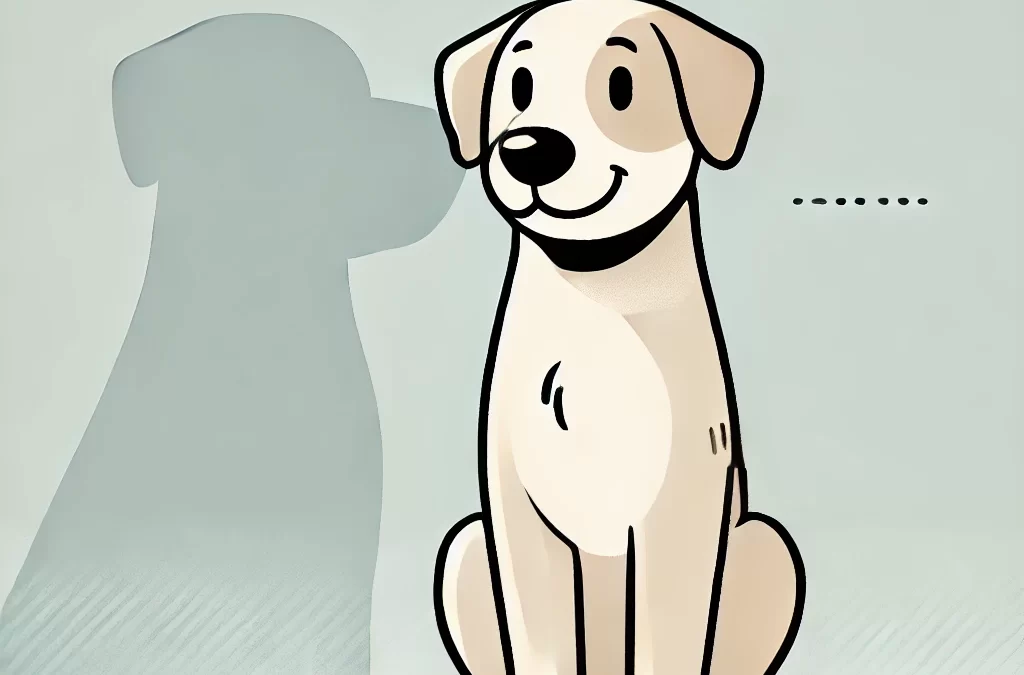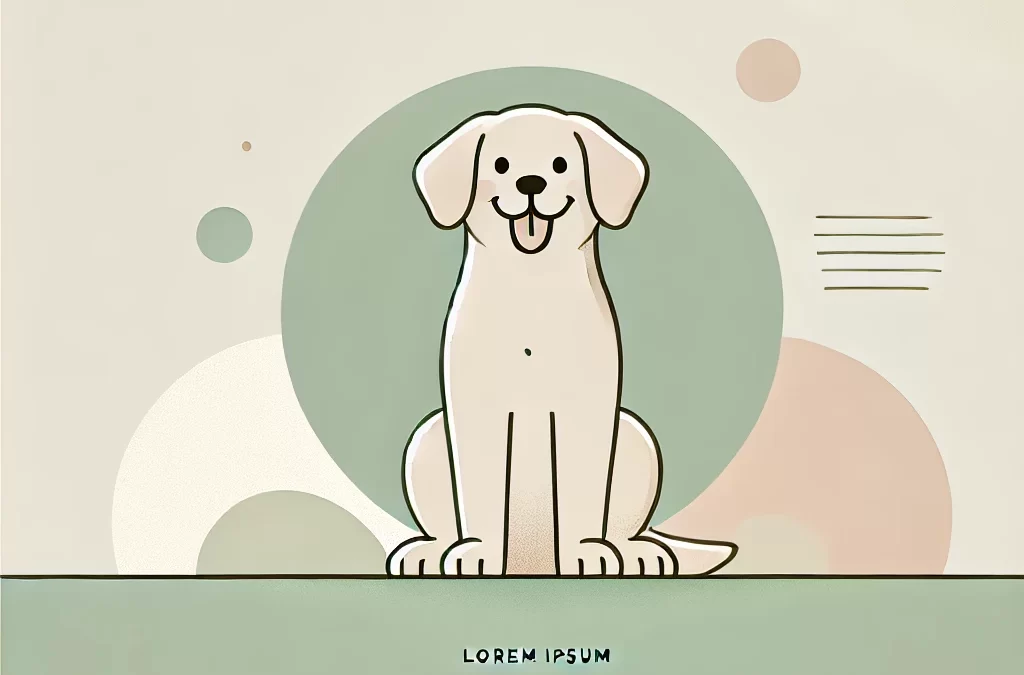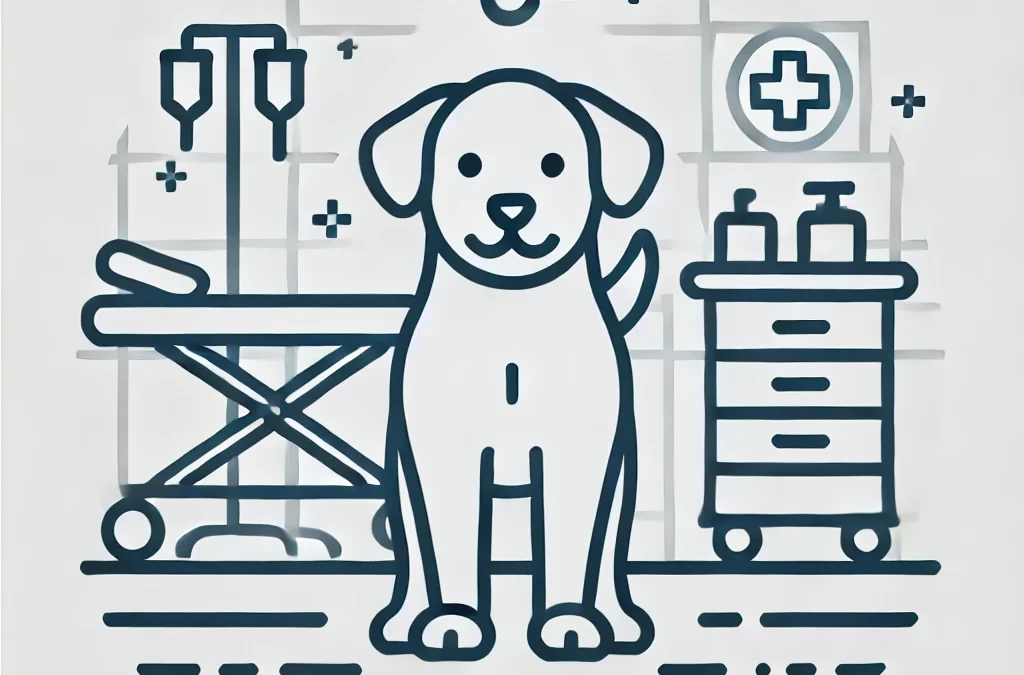
utworzone przez TCMVET | 22 listopada 2024 | Rak i guzy u psów
Mięsak kości, rodzaj raka kości, jest trudną diagnozą dla właścicieli psów. Podczas gdy konwencjonalne metody leczenia, takie jak amputacja i chemioterapia, mogą poprawić oczekiwaną długość życia, wielu szuka naturalnych terapii, aby wesprzeć jakość życia swoich zwierząt. Zrównoważone podejście łączące konwencjonalne metody z naturalnymi metodami leczenia może dać nadzieję i komfort psom z mięsakiem kości. Przyjrzyjmy się innowacyjnym, holistycznym strategiom wykraczającym poza konwencjonalne.
1. Wsparcie żywieniowe: podstawa leczenia
Odżywianie odgrywa kluczową rolę w leczeniu osteosarcomy. Dieta dostosowana do zwalczania stanów zapalnych i wspierania odporności może mieć znaczący wpływ.
- Wysokiej jakości białko: Zapewnia utrzymanie mięśni i zwalcza utratę wagi. Źródła obejmują chude mięso, ryby i jaja.
- Kwasy tłuszczowe omega-3Substancje te znajdują się w oleju rybim, zmniejszają stany zapalne i mogą spowalniać rozwój raka.
- Dieta niskowęglowodanowa:Komórki rakowe żywią się glukozą. Wybierz dietę bogatą w warzywa, takie jak szpinak i brokuły, unikając zbóż i warzyw skrobiowych.
Wskazówka:Wywar z kości, bogaty w kolagen i aminokwasy, łagodzi bóle stawów i zapewnia delikatne odżywienie.
2. Ziołowi sojusznicy w walce
Naturalne zioła mogą wspomagać leczenie raka poprzez łagodzenie stanów zapalnych, wzmacnianie odporności i potencjalne spowalnianie wzrostu guza.
- Kurkuma (Curcumin): Znany ze swoich właściwości przeciwzapalnych i przeciwnowotworowych. Połączenie kurkumy z czarnym pieprzem poprawia wchłanianie.
- Chuanxiong (lubczyk syczuański):Zioło stosowane w tradycyjnej medycynie chińskiej, uważane za wspomagające krążenie i łagodzące dolegliwości związane z guzem.
- Herbata Essiac:Mieszanka ziół zawierająca korzeń łopianu i śliski wiąz, często stosowana w celu wspomagania detoksykacji i wzmocnienia odporności.
Zawsze konsultuj się z lekarzem weterynarii specjalizującym się w ziołolecznictwie, aby mieć pewność bezpieczeństwa i właściwego dawkowania.
3. Suplementy ukierunkowane na wsparcie komórkowe
Suplementy mogą być pomocne w walce ze skutkami raka i poprawie ogólnego stanu zdrowia.
- Olejek CBD:Olejek CBD, znany ze swoich właściwości łagodzenia bólu i potencjalnego działania przeciwnowotworowego, może poprawić sprawność ruchową i zmniejszyć niepokój u psów z kostniakomięsakiem.
- Grzyby lecznicze:Odmiany takie jak reishi i turkey tail wzmacniają odporność i zawierają związki, które mogą hamować rozwój guza.
- Kadzidłowiec: Środek przeciwzapalny, który może łagodzić ból i wspomagać zdrowie stawów.
Notatka: Zawsze wybieraj suplementy zatwierdzone przez weterynarza i sprawdzaj jakość składników.
4. Dobre samopoczucie fizyczne i emocjonalne
- Akupunktura i masaż:Akupunktura może pomóc w łagodzeniu bólu, natomiast delikatny masaż poprawia krążenie i zmniejsza sztywność.
- Umiarkowane ćwiczenia:Dostosuj aktywności do możliwości swojego psa, koncentrując się na ćwiczeniach o niskim wpływie, jak np. pływanie.
- Wsparcie emocjonalne: Komfort i miłość odgrywają kluczową rolę w procesie gojenia psa. Spędzaj jakościowy czas, angażuj się w łagodną zabawę i zapewnij środowisko wolne od stresu.
5. Nowe terapie w sferze naturalnej
Innowacyjne podejścia poszerzają granice naturalnych metod leczenia kostniakomięsaka u psów:
- Tlenoterapia hiperbaryczna (HBOT):Zwiększa poziom tlenu w organizmie, co może spowolnić wzrost guza i przyspieszyć gojenie.
- Terapia Fotodynamiczna (PDT):Wykorzystuje związki światłoczułe i technologię laserową w celu nieinwazyjnego niszczenia nowotworów.
- Terapie oparte na peptydachTe innowacyjne suplementy stymulują naturalne procesy lecznicze organizmu na poziomie komórkowym.
6. Dostosowanie kompleksowego planu
Każdy pies jest wyjątkowy, a taki powinien być jego plan leczenia. Łączenie terapii naturalnych i konwencjonalnych wymaga stałej komunikacji z lekarzem weterynarii. Holistyczni weterynarze przeszkoleni w zakresie medycyny integracyjnej mogą zaoferować spersonalizowane wskazówki.
Serdeczne przypomnienie
Podczas gdy naturalne metody leczenia zapewniają wsparcie, są one najskuteczniejsze, gdy są stosowane wraz z konwencjonalnymi terapiami. Celem nie jest jedynie przedłużenie życia, ale zapewnienie wysokiej jakości życia ukochanemu pupilowi. Dzięki współczującemu i świadomemu podejściu możesz zapewnić swojemu psu komfort, opiekę i miłość podczas tej trudnej podróży.
Łącząc nowoczesne spostrzeżenia z naturalnymi, sprawdzonymi w czasie środkami, dajesz swojemu psu najlepszą szansę na życie pełne radości i godności. Razem możemy zdefiniować na nowo, jak wygląda leczenie psów z kostniakomięsakiem.

utworzone przez TCMVET | 21 listopada 2024 | Rak i guzy u psów
Jeśli chodzi o leczenie guzów komórek tucznych u psów, właściciele często znajdują się w morzu opcji leczenia. Wśród nich cymetydyna — lek pierwotnie opracowany do leczenia wrzodów — zyskała uwagę ze względu na swój potencjał do leczenia objawów i postępu tej złożonej choroby. Ale jaka dokładnie jest jej rola i jak dawkowanie wpływa na jej skuteczność? Zanurzmy się w temacie z nowej perspektywy.
Czym jest cymetydyna?
Cymetydyna należy do klasy leków znanych jako antagoniści receptora H2, zaprojektowanych w celu zmniejszenia produkcji kwasu żołądkowego. Podczas gdy jej głównym zastosowaniem są schorzenia żołądkowo-jelitowe, naukowcy odkryli dodatkowe korzyści, które rozszerzają jej zastosowanie na leczenie guzów komórek tucznych u psów.
Połączenie leży w histaminie. Guzy komórek tucznych uwalniają histaminę, co może prowadzić do różnych objawów, w tym wrzodów żołądka i stanów zapalnych. Blokując receptory H2, cymetydyna może pomóc złagodzić te skutki.
Dlaczego warto stosować cymetydynę w leczeniu guzów komórek tucznych?
- Zarządzanie objawami:Cymetydyna zmniejsza uwalnianie histaminy, pomagając kontrolować objawy takie jak wymioty, biegunka i dyskomfort wywołany zwiększoną kwasowością żołądka.
- Stabilizacja guza:Niektóre badania sugerują, że cymetydyna może pomóc spowolnić rozwój guza poprzez zmianę jego mikrośrodowiska, chociaż efekt ten jest wciąż przedmiotem badań.
- Rola pomocnicza:Cymetydyna jest często stosowana w ramach podejścia multimodalnego, jako uzupełnienie takich metod leczenia, jak zabieg chirurgiczny, chemioterapia lub terapie naturalne.
Dawkowanie: znalezienie złotego środka
Określenie właściwego dawkowania jest kluczowe dla osiągnięcia pożądanego efektu terapeutycznego. Jednak podejście „uniwersalne” nie działa w przypadku psów, ponieważ czynniki takie jak wielkość, wiek i ogólny stan zdrowia znacząco wpływają na dawkowanie.
- Ogólne wytyczne:Cymetydynę zazwyczaj podaje się doustnie w dawkach od 5 do 10 mg na kilogram (2,2 funta) masy ciała, dwa do trzech razy dziennie. Jednak zawsze postępuj zgodnie ze szczegółowymi zaleceniami lekarza weterynarii.
- Dostosowane dawkowanie: Dawki mogą się różnić w zależności od nasilenia objawów, stadium nowotworu i tego, czy pies otrzymuje dodatkowe leczenie. Dostosowania są powszechne i powinny być prowadzone na podstawie regularnego monitorowania.
Znaczenie nadzoru weterynaryjnego
Chociaż cymetydyna jest stosunkowo bezpieczna, nie jest pozbawiona skutków ubocznych. Potencjalne problemy obejmują biegunkę, letarg lub zmiany apetytu. Ponadto należy dokładnie rozważyć interakcje z innymi lekami, zwłaszcza jeśli pies przechodzi chemioterapię lub stosuje inne leki, takie jak NLPZ.
Nadzór weterynaryjny zapewnia:
- Precyzyjne dawkowanie.
- Monitorowanie skutków ubocznych i interakcji.
- Dostosowanie w oparciu o reakcję psa.
Terapie alternatywne i uzupełniające
Chociaż cymetydyna jest skutecznym narzędziem, często jest najbardziej skuteczna w połączeniu z innymi terapiami. Niektóre alternatywy obejmują:
- Naturalne suplementy:Zioła takie jak Chuanxiong (lubczyk syczuański) lub kurkuma mogą mieć właściwości przeciwzapalne i wspomagać ogólne samopoczucie.
- Dostosowanie dietyDieta uboga w histaminę może uzupełniać działanie cymetydyny, zmniejszając uwalnianie histaminy wywoływane przez niektóre pokarmy.
- Opieka holistyczna:Akupunktura, olejek CBD i inne terapie wspomagające mogą pomóc poprawić jakość życia psów z guzami komórek tucznych.
Przyszłe innowacje w leczeniu guzów komórek tucznych
Nowe badania nadal badają rolę cymetydyny i podobnych leków w onkologii weterynaryjnej. Od terapii ukierunkowanych po inhibitory histaminy, przyszłość leczenia guzów komórek tucznych u psów daje nadzieję na bardziej spersonalizowane i skuteczne rozwiązania.
Najważniejsze wnioski
Cymetydyna jest cennym sojusznikiem w leczeniu guzów komórek tucznych, ale jej skuteczność zależy od prawidłowego stosowania i integracji z szerszym planem leczenia. Dzięki ścisłej współpracy z lekarzem weterynarii i pozostawaniu na bieżąco z nowymi osiągnięciami możesz dać swojemu psu najlepszą szansę na wygodne i szczęśliwe życie.
Zamykające myśli
Jeśli u Twojego psa zdiagnozowano guzy komórek tucznych, nie wahaj się zbadać wszystkich dostępnych opcji. Chociaż cymetydyna może nie być lekarstwem, jej zdolność do radzenia sobie z objawami i wspierania ogólnego leczenia sprawia, że jest ważną częścią układanki. Dzięki dostosowanej opiece i holistycznemu podejściu Twój futrzany przyjaciel może nadal się rozwijać pomimo wyzwań.

utworzone przez TCMVET | 21 listopada 2024 | Rak i guzy u psów
Kiedy ukochany pies staje w obliczu problemów zdrowotnych, właściciele zwierząt często zwracają się do nowoczesnej diagnostyki, aby odkryć problem. Wśród nich ultrasonografia stała się narzędziem, po które sięgają weterynarze. Ale jak skuteczna jest w wykrywaniu raka u psów? Przyjrzyjmy się temu zagadnieniu dogłębnie, badając zarówno mocne, jak i słabe strony tej technologii.
Podstawy ultrasonografii w medycynie weterynaryjnej
Obrazowanie ultrasonograficzne, znane również jako sonografia, wykorzystuje fale dźwiękowe do tworzenia obrazów wewnętrznych narządów psa w czasie rzeczywistym. Jest szczególnie przydatne do badania tkanek miękkich, takich jak wątroba, nerki, śledziona i pęcherz. W przeciwieństwie do zdjęć rentgenowskich, które zapewniają statyczny obraz, ultrasonografia oferuje dynamiczne obrazy, umożliwiając lekarzom weterynarii ocenę funkcji narządów i wykrywanie nieprawidłowości.
Jak USG wykrywa raka
Ultradźwięki mogą pomóc zidentyfikować guzy, nieprawidłowe narośla tkanek lub nieregularne struktury narządów, które mogą wskazywać na raka. Na przykład:
- Lokalizacja guzów: Ultradźwięki mogą ujawnić rozmiar, kształt i lokalizację mas. Jest to szczególnie pomocne w przypadku nowotworów w jamie brzusznej, takich jak guzy wątroby lub nerek.
- Biopsje wspomagające:Chociaż badanie ultrasonograficzne nie pozwala na definitywne rozpoznanie raka, odgrywa ono kluczową rolę w wykonywaniu biopsji igłowych w celu pobrania próbek tkanek do analizy laboratoryjnej.
- Monitorowanie postępów:W przypadku psów poddawanych leczeniu raka ultrasonografia jest cennym narzędziem pozwalającym monitorować reakcję choroby na stosowane terapie.
Ograniczenia USG w wykrywaniu raka
Pomimo swoich zalet, ultradźwięki mają również pewne ograniczenia:
- Nie można potwierdzić raka: Ultrasonografia może zidentyfikować masy, ale nie może określić, czy są złośliwe (rakowe) czy łagodne (nierakowe). Biopsja lub zaawansowane obrazowanie, takie jak MRI lub CT, jest zwykle wymagane do potwierdzenia.
- Zależność operatora:Dokładność badania USG zależy od umiejętności i doświadczenia lekarza weterynarii. Błędna interpretacja obrazów może prowadzić do wyników fałszywie dodatnich lub fałszywie ujemnych.
- Nie nadaje się dla wszystkich nowotworów: Ultradźwięki są mniej skuteczne w wykrywaniu nowotworów kości, płuc lub obszarów o gęstych strukturach. W takich przypadkach bardziej odpowiednie są inne techniki obrazowania.
Kiedy rozważyć USG u psa
Jeśli u Twojego psa występują takie objawy, jak niewyjaśniona utrata wagi, wymioty, obrzęk lub letarg, weterynarz może zalecić USG jako część procesu diagnostycznego. Jest to nieinwazyjny, bezbolesny zabieg o minimalnym ryzyku, co czyni go preferowanym pierwszym krokiem w wielu przypadkach.
Przyszłe innowacje: poprawa możliwości wykrywania raka za pomocą ultrasonografii
Postępy w medycynie weterynaryjnej nieustannie udoskonalają technologię ultrasonograficzną. Techniki takie jak ultrasonografia z kontrastem i elastografia stają się obiecującymi narzędziami do lepszej identyfikacji tkanek nowotworowych. Te innowacje mogą wkrótce sprawić, że ultrasonografia będzie dokładniejsza w odróżnianiu złośliwych od łagodnych narośli.
Zrównoważone podejście do diagnostyki raka
Chociaż USG jest potężnym narzędziem diagnostycznym, najlepiej sprawdza się jako część kompleksowego podejścia diagnostycznego. Połączenie USG z innymi technikami, takimi jak badania krwi, biopsje i zaawansowane obrazowanie, zapewnia najdokładniejszą diagnozę i skuteczny plan leczenia dla Twojego psa.
Końcowe przemyślenia
Ultradźwięki są niezastąpionym narzędziem w medycynie weterynaryjnej, oferującym cenne informacje na temat zdrowia psa. Choć mają swoje ograniczenia, odgrywają kluczową rolę w wykrywaniu i leczeniu raka. Dzięki informowaniu się i ścisłej współpracy z lekarzem weterynarii możesz zapewnić swojemu futrzanemu towarzyszowi najlepszą możliwą opiekę, nawet w obliczu trudnych diagnoz.
4o

utworzone przez TCMVET | 20 listopada 2024 | Rak i guzy u psów
Nowotwór przenoszony drogą płciową u psów (TVT) jest unikalną formą raka u psów, przenoszoną głównie przez bezpośredni kontakt. Podczas gdy interwencja weterynaryjna jest zazwyczaj konieczna, rośnie zainteresowanie opieką domową uzupełniającą leczenie medyczne. W tym artykule zbadamy, w jaki sposób innowacyjne, naturalne i holistyczne praktyki mogą odgrywać kluczową rolę w leczeniu TVT w domu, podkreślając znaczenie partnerstwa z lekarzem weterynarii.
Zrozumienie TVT: krótki przegląd
TVT to zaraźliwy guz, który atakuje zewnętrzne narządy płciowe, pysk lub nos psów. Typowe objawy obejmują:
- Widoczne wzrosty guzów
- Krwawienie lub upławy
- Dyskomfort lub ból w dotkniętych obszarach
Podstawowe leczenie obejmuje chemioterapię (zwykle z winkrystyną), operację lub radioterapię. Jednak te metody leczenia mogą nie być zawsze dostępne lub przystępne cenowo dla niektórych właścicieli zwierząt domowych. W tym miejscu domowa opieka wspomagająca może mieć znaczenie.
Rewolucjonizowanie opieki domowej nad psami dzięki TVT
1. Odżywianie wzmacniające odporność
Układ odpornościowy psa odgrywa kluczową rolę w walce z rakiem. Dostarczanie posiłków o dużej zawartości składników odżywczych może wspierać ich ogólny stan zdrowia. Rozważ:
- Źródła chudego białka:Indyk, kurczak i ryby dla utrzymania masy mięśniowej.
- Produkty spożywcze zwalczające raka:Borówki, marchewki i brokuły zawierają przeciwutleniacze, które zwalczają stres oksydacyjny.
- kwasy tłuszczowe omega-3:Zawarte w oleju rybim lub oleju lnianym substancje pomagają łagodzić stany zapalne.
Wskazówka dla profesjonalistów:Unikaj produktów o wysokiej zawartości cukru i zbóż, które mogą nasilać rozwój guza.
2. Naturalne środki lecznicze i zioła
Naturalne terapie mogą przynieść ulgę i pomóc w radzeniu sobie z objawami TVT. Niektóre obiecujące opcje obejmują:
- Kurkuma (Curcumin): Znany ze swoich właściwości przeciwzapalnych i przeciwnowotworowych.
- Chuanxiong (lubczyk syczuański):Tradycyjne chińskie zioło, które poprawia krążenie i wspomaga gojenie.
- Olejek CBD:Może pomóc zmniejszyć stan zapalny, złagodzić ból i poprawić ogólny komfort.
Ważny:Zawsze skonsultuj się z lekarzem weterynarii, aby ustalić bezpieczne dawkowanie.
3. Tworzenie środowiska wolnego od stresu
Stres może osłabić układ odpornościowy Twojego psa. Zapewnij swojemu pupilowi spokojne i komfortowe otoczenie poprzez:
- Zapewnienie spokojnego miejsca do odpoczynku, z dala od domowego hałasu.
- Stosowanie środków uspokajających, np. dyfuzorów z olejkiem lawendowym (w dobrze wentylowanym pomieszczeniu).
- Podejmowanie lekkich, mało stresujących aktywności, aby utrzymać dzieci w aktywności i dobrym samopoczuciu.
4. Opieka nad ranami i guzami
Jeśli obecne są zewnętrzne guzy, mogą one krwawić lub ulec zakażeniu. Opieka domowa obejmuje:
- Delikatne czyszczenie zmienionego chorobowo obszaru roztworem soli fizjologicznej, aby zapobiec zakażeniu.
- Stosowanie maści zatwierdzonych przez lekarzy weterynarii w celu przyspieszenia gojenia.
- Monitorowanie objawów zakażenia, takich jak zaczerwienienie, obrzęk lub nieprzyjemny zapach.
5. Wzmocnienie zdrowia jelit
Psy poddawane leczeniu TVT często cierpią na problemy trawienne. Probiotyki i prebiotyki mogą poprawić zdrowie jelit i zwiększyć wchłanianie składników odżywczych. Do ich diety można dodać jogurt (bez dodatku cukru) lub weterynaryjne suplementy probiotyczne.
6. Terapie alternatywne
- Akupresura i masaż:Może pomóc poprawić krążenie krwi i zmniejszyć ból.
- Homeopathy:Środki zaradcze takie jak Arsenicum album Lub Tuja są czasami stosowane w leczeniu raka (pod nadzorem lekarza weterynarii).
Co leczenie domowe może i czego nie może zrobić
Chociaż takie podejście może poprawić komfort i ogólne samopoczucie Twojego psa, nie może zastąpić profesjonalnej opieki medycznej. TVT to poważny stan, który często wymaga chemioterapii lub innych zabiegów weterynaryjnych w celu wyleczenia. Opieka domowa jest najlepiej stosowana jako podejście uzupełniające w celu poprawy jakości życia psa i wsparcia rekonwalescencji.
Kluczem jest holistyczne podejście
Pomysł leczenia TVT w domu nie polega na znalezieniu cudownego lekarstwa, ale na stworzeniu środowiska, w którym pies czuje się pielęgnowany i wspierany. Łącząc leczenie weterynaryjne z innowacyjnymi praktykami opieki domowej, możesz dać swojemu futrzanemu przyjacielowi najlepszą szansę na wyzdrowienie.
Ostatnia myśl
Zarządzanie TVT w domu wymaga zaangażowania, kreatywności i współpracy z lekarzami weterynarii. Nie chodzi tylko o leczenie choroby; chodzi o przywrócenie nadziei, zdrowia i szczęścia w życiu Twojego psa. Dzięki temu holistycznemu podejściu właściciele zwierząt mogą aktywnie uczestniczyć w podróży uzdrawiającej swojego psa, zapewniając mu miłość i opiekę, na jakie zasługuje.

utworzone przez TCMVET | 18 listopada 2024 | Rak i guzy u psów
Białaczka u psów jest często określana jako „cicha choroba”. W momencie pojawienia się objawów choroba może być już zaawansowana. Ale co, jeśli moglibyśmy słuchać subtelnych szeptów tego ukrytego wroga, zanim uderzy głośno? Rozpoznanie wczesnych objawów białaczki u psów może nie tylko uratować im życie, ale także radykalnie poprawić ich jakość życia. Rozpocznijmy niekonwencjonalne badanie tych wczesnych sygnałów ostrzegawczych, łącząc kliniczne spostrzeżenia z holistycznym podejściem do opieki nad psami.
Odkodowywanie subtelnych wskazówek
Białaczka często maskuje się pod innymi, mniej poważnymi chorobami. Wczesne wykrycie wymaga bystrego oka i intuicyjnego zrozumienia zachowania psa. Oto dyskretne oznaki, na które należy zwrócić uwagę:
- Nietypowe zmęczenie lub letarg Twój zazwyczaj energiczny szczeniak nagle woli leniuchowanie od zabawy. Ta letarg nie jest tylko wynikiem starzenia się lub ciężkiego dnia; to sposób, w jaki ciało sygnalizuje, że coś głębszego może być nie tak.
- Bladość dziąseł i języka Zdrowe dziąsła powinny być różowe jak guma balonowa. Jeśli dziąsła lub język Twojego psa wydają się blade lub białe, może to wskazywać na anemię, powszechny wczesny objaw białaczki spowodowany niską produkcją czerwonych krwinek.
- Uporczywe lub niewyjaśnione zakażenia Częste infekcje, które nie reagują na leczenie, mogą wskazywać na osłabiony układ odpornościowy. Białaczka upośledza funkcję białych krwinek, czyniąc psy podatnymi na inwazje bakteryjne, grzybicze lub wirusowe.
- Obrzęk węzłów chłonnych Powiększone węzły chłonne, szczególnie wokół szyi, ramion lub tylnych nóg, są wyraźnym znakiem, że coś jest nie tak. Choć nie jest to objaw wyłącznie białaczki, warto go zbadać.
- Unexplained Weight Loss Pies z białaczką może stracić na wadze, mimo że ma apetyt. Dzieje się tak, ponieważ choroba przejmuje zasoby organizmu, co prowadzi do zaniku mięśni i wyczerpania energii.
- Siniaki lub krwawienie Uważaj na małe czerwone lub fioletowe kropki pod skórą (wybroczyny) lub niewyjaśnione siniaki. Białaczka zaburza produkcję płytek krwi, co prowadzi do problemów z krzepnięciem.
- Utrata apetytu lub wymioty Choć objawy te są typowe dla wielu chorób, ich uporczywość może być objawem choroby podstawowej, np. białaczki.
Dlaczego wczesne wykrywanie ma znaczenie
Im wcześniej wykryto białaczkę, tym lepsze są wyniki leczenia. Wielu właścicieli psów zakłada, że sporadyczna letarg lub utrata apetytu są normalne, zwłaszcza u starszych psów, ale ignorowanie tych objawów może oznaczać utratę okazji do szybkiej interwencji. Rutynowe badania krwi są prostym, ale skutecznym narzędziem w wykrywaniu białaczki, zanim się rozwinie.
Poza klinicznością: połączenie emocjonalne
Psy są mistrzami w ukrywaniu bólu. Często zmiany w zachowaniu, takie jak wycofywanie się z interakcji rodzinnych lub sprawianie wrażenia „niezrównoważonego”, są wczesnymi emocjonalnymi sygnałami cierpienia. Budowanie głębokiej więzi ze swoim pupilem pozwala wychwycić te subtelności.
Holistyczne spojrzenie na białaczkę u psów
Podczas gdy tradycyjne metody leczenia, takie jak chemioterapia i sterydy, są powszechne, integracja opieki holistycznej może poprawić jakość życia Twojego psa. Oto kilka opcji:
- Wsparcie żywieniowe
- Włącz do jadłospisu produkty bogate w przeciwutleniacze, takie jak borówki i szpinak, aby wzmocnić układ odpornościowy.
- Bulion kostny dostarcza niezbędnych składników odżywczych i pomaga zachować apetyt.
- Naturalne suplementy
- Kurkuma:Jego właściwości przeciwzapalne mogą wspomagać ogólne samopoczucie.
- Grzyby Reishi:Znane ze swoich właściwości wzmacniających odporność i przeciwnowotworowych.
- Radzenia sobie ze stresem
- Delikatne masaże i aromaterapia z zastosowaniem bezpiecznych dla psów olejków, np. lawendowego, mogą złagodzić stres, który może zaostrzać objawy.
- Ziołowe środki zaradcze
- Zioła tradycyjnej medycyny chińskiej, takie jak traganek I do cholery może wspierać odporność i poziom energii.
Środki zapobiegawcze: czy możemy utrzymać przewagę?
Chociaż białaczki nie zawsze da się zapobiec, pewne działania mogą obniżyć czynniki ryzyka:
- Regularne kontrole weterynaryjne:Roczne badania krwi pozwalają na wczesne wykrycie nieprawidłowości.
- Ogranicz narażenie na toksyny: Unikaj stosowania pestycydów, herbicydów i palenia w pobliżu zwierząt domowych.
- Utrzymuj zdrową dietęZrównoważona dieta bogata w składniki odżywcze wzmacnia układ odpornościowy Twojego psa.
Kiedy działać
Jeśli u Twojego psa występuje więcej niż jeden z tych wczesnych objawów, nie czekaj. Natychmiast skonsultuj się z weterynarzem. Proste badanie krwi może dać odpowiedzi, a jeśli zostanie zdiagnozowana białaczka, wczesna interwencja może znacznie wydłużyć życie Twojego psa.
Promyk nadziei
Białaczka nie musi być wyrokiem śmierci. Dzięki postępom w opiece weterynaryjnej, holistycznemu wsparciu i niezachwianej miłości właściciela zwierzęcia, psy ze zdiagnozowaną białaczką mogą żyć pełnią życia. Kluczem jest czujność, edukacja i podejmowanie proaktywnych kroków.
Wnioski
Wczesne objawy białaczki u psów są jak szepty na wietrze — łatwo je przeoczyć, ale koniecznie trzeba je usłyszeć. Pozostając w kontakcie z fizycznymi i emocjonalnymi wskazówkami swojego psa, możesz przechwycić tego ukrytego wroga, zanim się pojawi. W końcu nasi czworonożni towarzysze zasługują na nic innego, jak tylko na nasze absolutnie najlepsze wsparcie w chwilach, gdy tego potrzebują.

utworzone przez TCMVET | 16 listopada 2024 | Rak i guzy u psów
Kiedy słyszymy słowo „guz”, nasze myśli często przeskakują do najgorszego scenariusza: raka. Jednak nie wszystkie guzy są złośliwe. W rzeczywistości łagodne guzy jelitowe u psów są o wiele mniej groźne i często można je skutecznie leczyć przy odpowiednim podejściu. Ten artykuł zagłębia się w niuanse tych łagodnych narośli, pomagając zrozumieć ich przyczyny, objawy i strategie leczenia.
Czym są łagodne nowotwory jelit?
Łagodne guzy jelitowe to nienowotworowe narośla, które rozwijają się w przewodzie pokarmowym (GI) u psów. Chociaż nie atakują otaczających tkanek ani nie rozprzestrzeniają się na inne części ciała, ich obecność może nadal prowadzić do dyskomfortu lub problemów trawiennych, jeśli urosną na tyle, że zablokują jelita lub zakłócą normalne funkcjonowanie.
Najczęstsze rodzaje łagodnych nowotworów jelit u psów:
- Gruczolaki:Powstają z komórek gruczołowych wyściełających jelita.
- Mięśniaki gładkokomórkowe:Pochodzą z komórek mięśni gładkich w ścianie jelita.
- Polipy:Małe narośla wystające ze ścianki jelit.
Przyczyny: Dlaczego powstają te guzy?
Chociaż dokładna przyczyna występowania łagodnych guzów jelit u psów nie jest znana, może mieć na nie wpływ kilka czynników:
- Genetics:Niektóre rasy, np. owczarki niemieckie i collie, mogą mieć predyspozycje.
- Chronic Inflammation:Długotrwały stan zapalny przewodu pokarmowego może zwiększać ryzyko nieprawidłowego wzrostu komórek.
- Czynniki dietetyczne:Dieta złej jakości, uboga w błonnik, może mieć wpływ na rozwój polipów.
Objawy: na co zwrócić uwagę
Łagodne guzy często rosną powoli, przez co objawy na początku są subtelne. Z czasem, w miarę powiększania się guza, mogą pojawić się następujące objawy:
- Przewlekłe wymioty lub biegunka:Z powodu podrażnienia lub częściowego zablokowania.
- Utrata wagi:Jeśli guz wpływa na wchłanianie składników odżywczych.
- Krew w stolcu:Jasnoczerwony lub ciemny, w zależności od umiejscowienia guza.
- Abdominal Pain:Jeśli guz powoduje wzdęcia lub niedrożność.
- Zmiana apetytu:Wahania między głodem a odmową jedzenia.
Czerwona flaga:Każdy uporczywy objaw ze strony przewodu pokarmowego powinien skłonić do wizyty u weterynarza w celu przeprowadzenia dokładnej oceny.
Diagnoza: Określenie problemu
Diagnozowanie łagodnych guzów jelit wymaga zastosowania kombinacji technik:
- Fizyczny egzamin:Badanie palpacyjne jamy brzusznej w celu wykrycia guzów.
- Obrazowanie:Zdjęcia rentgenowskie lub USG w celu uwidocznienia przewodu pokarmowego.
- Endoskopia:Badanie wspomagane kamerą, mające na celu obejrzenie nowotworu i potencjalną biopsję.
- Biopsja:Ostateczną diagnozę stawia się na podstawie analizy próbki tkanki, która ma na celu określenie, czy guz jest łagodny.
Leczenie: Opcje leczenia łagodnych nowotworów
Chociaż łagodne nowotwory nie zagrażają życiu, często wymagają leczenia w celu złagodzenia objawów lub zapobiegania powikłaniom.
1. Usunięcie chirurgiczne
- Kiedy konieczna jest operacja? Jeśli guz powoduje niedrożność lub poważne objawy.
- Wynik:Chirurgia zazwyczaj ma charakter leczniczy w przypadku łagodnych zmian, a psy szybko rekonwalescują po zabiegu.
2. Polipektomia endoskopowa
- Co to jest? Mniej inwazyjna metoda usuwania polipów i małych guzów za pomocą endoskopu.
- Zalety:Krótszy czas rekonwalescencji i minimalny dyskomfort.
3. Dostosowania dietetyczne
- Dlaczego to pomagaDieta bogata w błonnik może zmniejszyć stan zapalny i wspomóc gojenie się jelit po leczeniu.
- Produkty spożywcze do włączenia:Dynia, gotowane słodkie ziemniaki i karma polecana przez weterynarza.
4. Monitorowanie
- Dla małych guzów:Regularne kontrole mające na celu monitorowanie wzrostu bez natychmiastowej interwencji.
Prognoza: Czego się spodziewać
Łagodne guzy jelitowe mają zazwyczaj doskonałe rokowanie, jeśli są odpowiednio leczone. Regularne wizyty u weterynarza i badania kontrolne są kluczowe, aby upewnić się, że guz nie nawróci lub nie spowoduje dalszych problemów.
Zapobieganie: Czy można zmniejszyć ryzyko?
Choć nie da się zagwarantować profilaktyki, poniższe kroki mogą zmniejszyć ryzyko wystąpienia u psa łagodnych guzów jelit:
- Zbilansowana dieta:Dodaj do swojej diety wysokiej jakości białka, zdrowe tłuszcze i odpowiednią ilość błonnika.
- Regularne wizyty u weterynarza:Rutynowe badania kontrolne pozwalają wykryć potencjalne problemy na wczesnym etapie.
- Obserwuj objawy:Wczesne wykrycie często prowadzi do prostszych, mniej inwazyjnych metod leczenia.
Unikalna perspektywa: jelita i ogólny stan zdrowia
Co ciekawe, zdrowie jelit Twojego psa jest ściśle związane z jego ogólnym samopoczuciem. Obecność łagodnego guza może sygnalizować ukryte zaburzenia równowagi, takie jak stan zapalny lub zła dieta, które zasługują na uwagę. Leczenie guza to tylko część podróży — zajęcie się przyczynami pierwotnymi zapewnia, że Twój pies pozostanie zdrowy i pełen energii.
Wnioski: przekształcanie wyzwań w szanse
Łagodne guzy jelitowe u psów, choć niepokojące, są możliwe do opanowania i często uleczalne. Przypominają o priorytetowym traktowaniu zdrowia jelit, dostarczaniu pożywnych posiłków i utrzymywaniu silnej współpracy z lekarzem weterynarii. Dzięki trosce i czujności Twój futrzany towarzysz może nadal cieszyć się szczęśliwym, wygodnym życiem.






